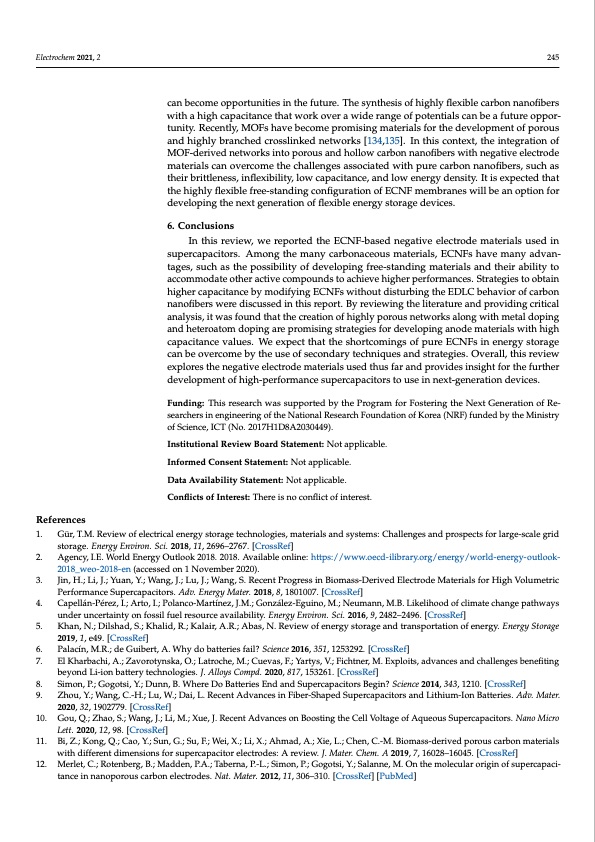
PDF Publication Title:
Text from PDF Page: 010
Electrochem 2021, 2 245 References can become opportunities in the future. The synthesis of highly flexible carbon nanofibers with a high capacitance that work over a wide range of potentials can be a future oppor- tunity. Recently, MOFs have become promising materials for the development of porous and highly branched crosslinked networks [134,135]. In this context, the integration of MOF-derived networks into porous and hollow carbon nanofibers with negative electrode materials can overcome the challenges associated with pure carbon nanofibers, such as their brittleness, inflexibility, low capacitance, and low energy density. It is expected that the highly flexible free-standing configuration of ECNF membranes will be an option for developing the next generation of flexible energy storage devices. 6. Conclusions In this review, we reported the ECNF-based negative electrode materials used in supercapacitors. Among the many carbonaceous materials, ECNFs have many advan- tages, such as the possibility of developing free-standing materials and their ability to accommodate other active compounds to achieve higher performances. Strategies to obtain higher capacitance by modifying ECNFs without disturbing the EDLC behavior of carbon nanofibers were discussed in this report. By reviewing the literature and providing critical analysis, it was found that the creation of highly porous networks along with metal doping and heteroatom doping are promising strategies for developing anode materials with high capacitance values. We expect that the shortcomings of pure ECNFs in energy storage can be overcome by the use of secondary techniques and strategies. Overall, this review explores the negative electrode materials used thus far and provides insight for the further development of high-performance supercapacitors to use in next-generation devices. Funding: This research was supported by the Program for Fostering the Next Generation of Re- searchers in engineering of the National Research Foundation of Korea (NRF) funded by the Ministry of Science, ICT (No. 2017H1D8A2030449). Institutional Review Board Statement: Not applicable. Informed Consent Statement: Not applicable. Data Availability Statement: Not applicable. Conflicts of Interest: There is no conflict of interest. 1. Gür, T.M. Review of electrical energy storage technologies, materials and systems: Challenges and prospects for large-scale grid storage. Energy Environ. Sci. 2018, 11, 2696–2767. [CrossRef] 2. Agency, I.E. World Energy Outlook 2018. 2018. Available online: https://www.oecd-ilibrary.org/energy/world-energy-outlook- 2018_weo-2018-en (accessed on 1 November 2020). 3. Jin, H.; Li, J.; Yuan, Y.; Wang, J.; Lu, J.; Wang, S. Recent Progress in Biomass-Derived Electrode Materials for High Volumetric Performance Supercapacitors. Adv. Energy Mater. 2018, 8, 1801007. [CrossRef] 4. Capellán-Pérez, I.; Arto, I.; Polanco-Martínez, J.M.; González-Eguino, M.; Neumann, M.B. Likelihood of climate change pathways under uncertainty on fossil fuel resource availability. Energy Environ. Sci. 2016, 9, 2482–2496. [CrossRef] 5. Khan, N.; Dilshad, S.; Khalid, R.; Kalair, A.R.; Abas, N. Review of energy storage and transportation of energy. Energy Storage 2019, 1, e49. [CrossRef] 6. Palacín, M.R.; de Guibert, A. Why do batteries fail? Science 2016, 351, 1253292. [CrossRef] 7. El Kharbachi, A.; Zavorotynska, O.; Latroche, M.; Cuevas, F.; Yartys, V.; Fichtner, M. Exploits, advances and challenges benefiting beyond Li-ion battery technologies. J. Alloys Compd. 2020, 817, 153261. [CrossRef] 8. Simon, P.; Gogotsi, Y.; Dunn, B. Where Do Batteries End and Supercapacitors Begin? Science 2014, 343, 1210. [CrossRef] 9. Zhou, Y.; Wang, C.-H.; Lu, W.; Dai, L. Recent Advances in Fiber-Shaped Supercapacitors and Lithium-Ion Batteries. Adv. Mater. 2020, 32, 1902779. [CrossRef] 10. Gou, Q.; Zhao, S.; Wang, J.; Li, M.; Xue, J. Recent Advances on Boosting the Cell Voltage of Aqueous Supercapacitors. Nano Micro Lett. 2020, 12, 98. [CrossRef] 11. Bi, Z.; Kong, Q.; Cao, Y.; Sun, G.; Su, F.; Wei, X.; Li, X.; Ahmad, A.; Xie, L.; Chen, C.-M. Biomass-derived porous carbon materials with different dimensions for supercapacitor electrodes: A review. J. Mater. Chem. A 2019, 7, 16028–16045. [CrossRef] 12. Merlet, C.; Rotenberg, B.; Madden, P.A.; Taberna, P.-L.; Simon, P.; Gogotsi, Y.; Salanne, M. On the molecular origin of supercapaci- tance in nanoporous carbon electrodes. Nat. Mater. 2012, 11, 306–310. [CrossRef] [PubMed]PDF Image | Review of Electrospun Carbon Nanofiber-Based Negative Electrode Materials

PDF Search Title:
Review of Electrospun Carbon Nanofiber-Based Negative Electrode MaterialsOriginal File Name Searched:
A_Review_of_Electrospun_Carbon_Nanofiber-Based_Neg.pdfDIY PDF Search: Google It | Yahoo | Bing
Sulfur Deposition on Carbon Nanofibers using Supercritical CO2 Sulfur Deposition on Carbon Nanofibers using Supercritical CO2. Gamma sulfur also known as mother of pearl sulfur and nacreous sulfur... More Info
CO2 Organic Rankine Cycle Experimenter Platform The supercritical CO2 phase change system is both a heat pump and organic rankine cycle which can be used for those purposes and as a supercritical extractor for advanced subcritical and supercritical extraction technology. Uses include producing nanoparticles, precious metal CO2 extraction, lithium battery recycling, and other applications... More Info
| CONTACT TEL: 608-238-6001 Email: greg@infinityturbine.com | RSS | AMP |